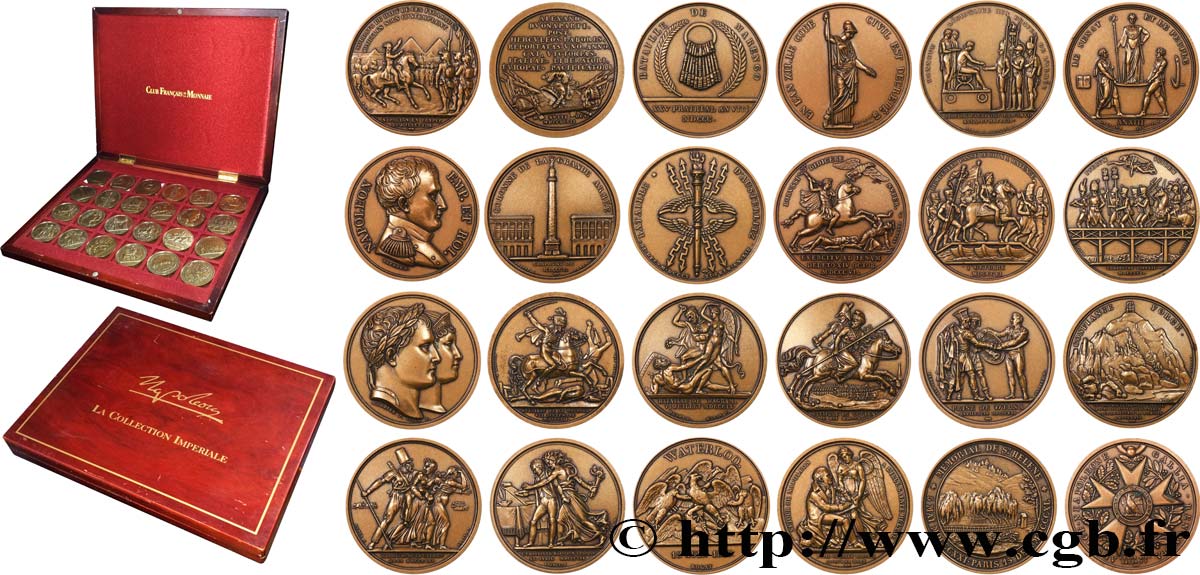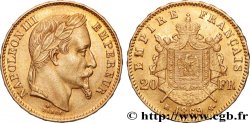fme_708699 - NAPOLEON'S EMPIRE Coffret de 24 médailles, refrappe, Histoire de Napoléon Ier
400.00 €约 3316.00 CNY
数量
加入购物车

种类 Coffret de 24 médailles, refrappe, Histoire de Napoléon Ier
日期: n.d.
材质 bronze
直径 42 mm
模子方针 12 h.
重量 1793,40 g.
侧面 lisse
印模 corne d’abondance
关于品相的说明
Exemplaires présentant quelques coups et rayures. Bel ensemble. La boîte présente quelques coups et rayures
家谱
Cet exemplaire provient de la Collection MARINECHE
正面
正面的文字 (DIVERSES LÉGENDES).
背面
背面的文字 ANÉPIGRAPHE.
背面的说明书 Aigle, ailes éployées, couronné par une Victoire, les serres sur un foudre, signé : DENON / D.T // JALEY F. / 1807 .
评论
Attention ! En fonction du lieu d’expédition, ce coffret peut donner lieu à des frais de port supplémentaires.
Be aware that in function of the shipping place, this box of medals may rise the shipping fees.
Ce coffret en bois de 24 médailles, timbré LA COLLECTION IMPERIALE, édité par le Club français de la Monnaie, retrace le parcours et histoire de Napoléon Ier :
- Alexandre Bonaparte, Octobre 1797, poids : 48,05g, diamètre : 40,5 mm
- Conquête de l’Egypte, 1798, poids : 47,15g, diamètre : 41,5 mm
- Bataille de Marengo, juin 1800; poids : 47,72g, diamètre : 41 mm
- Code civil, an XII (1803-1804), poids : 48,12g, diamètre : 41 mm
- Honneur légionnaire aux braves de l’Armée, Août 1804, poids : 47,37g, diamètre : 41 mm
- Le Sénat et le peuple, an XIII (1804-1805), poids : 47,49g, diamètre : 40,5 mm
- Colonne de la Grande Armée, 1805; poids : 47,65g, diamètre : 41,5 mm
- Bataille d’Austerlitz, décembre 1805; poids : 49,18g, diamètre : 41,5 mm
- Passage du Rhin à Mayence, octobre 1806, poids : 49,51g, diamètre : 41,5 mm
- Armée prussienne détruite à Iéna, Octobre 1806, poids : 48,46g, diamètre : 41,5 mm
- Buste Napoléon Empereur et Roi par Brenet, 1807, poids : 48,81g, diamètre : 41 mm
- Iterum Ibidem, Juillet 1809, poids : 49,85g, diamètre : 41,5 mm
- Bataille de Wagram, Juillet 1809, poids : 45,78g, diamètre : 40,5 mm
- Mariage Napoléon Ier et Marie Louise, poids : 48,61g, diamètre : 41,5 mm
- Prise de Wilna, juin 1812; poids : 47,39g, diamètre : 41 mm
- Bataille de la Moskowa, septembre 1812; poids : 49,57g, diamètre : 41 mm
- Bataille de Lutzen, mai 1813; poids : 49,48g, diamètre : 41,5 mm
- Confiance et force, Défense de l’Empire, 1813; poids : 49,50g, diamètre : 41 mm
- Malheurs de la guerre, Mars 1814, poids : 47,81g, diamètre : 40,5 mm
- Abdication de Napoléon Ier, Avril 1814, poids : 48,91g, diamètre : 41 mm
- Waterloo, 1815, poids : 46,71g, diamètre : 42 mm
- Séjour de Napoléon à l’Île Sainte Hélène, octobre 1815, poids : 48,30g, diamètre : 41 mm
- Mémorial de Sainte Hélène, Mai 1821; poids : 47,95g, diamètre : 40,5 mm
- Légion d’honneur, poids : 47,84g, diamètre : 41 mm
POIDS TOTAL avec le coffret : 1793,40g.
Be aware that in function of the shipping place, this box of medals may rise the shipping fees.
Ce coffret en bois de 24 médailles, timbré LA COLLECTION IMPERIALE, édité par le Club français de la Monnaie, retrace le parcours et histoire de Napoléon Ier :
- Alexandre Bonaparte, Octobre 1797, poids : 48,05g, diamètre : 40,5 mm
- Conquête de l’Egypte, 1798, poids : 47,15g, diamètre : 41,5 mm
- Bataille de Marengo, juin 1800; poids : 47,72g, diamètre : 41 mm
- Code civil, an XII (1803-1804), poids : 48,12g, diamètre : 41 mm
- Honneur légionnaire aux braves de l’Armée, Août 1804, poids : 47,37g, diamètre : 41 mm
- Le Sénat et le peuple, an XIII (1804-1805), poids : 47,49g, diamètre : 40,5 mm
- Colonne de la Grande Armée, 1805; poids : 47,65g, diamètre : 41,5 mm
- Bataille d’Austerlitz, décembre 1805; poids : 49,18g, diamètre : 41,5 mm
- Passage du Rhin à Mayence, octobre 1806, poids : 49,51g, diamètre : 41,5 mm
- Armée prussienne détruite à Iéna, Octobre 1806, poids : 48,46g, diamètre : 41,5 mm
- Buste Napoléon Empereur et Roi par Brenet, 1807, poids : 48,81g, diamètre : 41 mm
- Iterum Ibidem, Juillet 1809, poids : 49,85g, diamètre : 41,5 mm
- Bataille de Wagram, Juillet 1809, poids : 45,78g, diamètre : 40,5 mm
- Mariage Napoléon Ier et Marie Louise, poids : 48,61g, diamètre : 41,5 mm
- Prise de Wilna, juin 1812; poids : 47,39g, diamètre : 41 mm
- Bataille de la Moskowa, septembre 1812; poids : 49,57g, diamètre : 41 mm
- Bataille de Lutzen, mai 1813; poids : 49,48g, diamètre : 41,5 mm
- Confiance et force, Défense de l’Empire, 1813; poids : 49,50g, diamètre : 41 mm
- Malheurs de la guerre, Mars 1814, poids : 47,81g, diamètre : 40,5 mm
- Abdication de Napoléon Ier, Avril 1814, poids : 48,91g, diamètre : 41 mm
- Waterloo, 1815, poids : 46,71g, diamètre : 42 mm
- Séjour de Napoléon à l’Île Sainte Hélène, octobre 1815, poids : 48,30g, diamètre : 41 mm
- Mémorial de Sainte Hélène, Mai 1821; poids : 47,95g, diamètre : 40,5 mm
- Légion d’honneur, poids : 47,84g, diamètre : 41 mm
POIDS TOTAL avec le coffret : 1793,40g.








 对产品描述纠错
对产品描述纠错 打印
打印 分享我的选择
分享我的选择 提问
提问 Consign / sell
Consign / sell
 产品介绍
产品介绍















